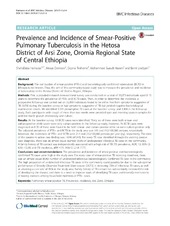| dc.description.abstract | Background: The real burden of smear-positive (PTB+) and bacteriologically confirmed tuberculosis (BCTB) in Ethiopia is not known. Thus, the aim of this community-based study was to measure the prevalence and incidence of tuberculosis in the Hetosa District of Oromia Region, Ethiopia. Methods: First, a population-based cross-sectional survey was conducted on a total of 33,073 individuals aged ≥ 15 years to determine the prevalence of PTB+ and BCTB cases. Then, in order to determine the incidence, a prospective follow-up was carried out on 32,800 individuals found to be either free from symptoms suggestive of TB (SSTB) during the baseline survey or had symptoms suggestive of TB but yielded negative bacteriological examination results. We identified 1,041 presumptive TB cases at the baseline survey, and 1,468 in the follow-up study. Each participants with cough of more than two weeks were provided spot and morning sputum samples for acid-fast bacilli sputum microscopy and culture. Results: At the baseline survey, 43 BCTB cases were identified. Thirty six of these were both smear- and culture-positive while seven were only culture-positive. In the follow-up study, however, 76 BCTB cases were diagnosed and 70 of these were found to be both smear- and culture-positive while six were culture-positive only. The adjusted prevalence of PTB+ and BCTB in the study area was 109 and 132/100,000 persons, respectively. Moreover, the incidences of PTB+ and BCTB were 214 and 232/100,000 persons per year (py), respectively. The ratio of the passive to active case finding was 1:0.96 (45/43). For every TB case identified through the existing passive case diagnosis, there was an almost equal number (0.96) of undiagnosed infectious TB cases in the community. A family history of TB contact was independently associated with a high risk of TB (TB prevalence, AOR, 13; 95% CI: 6.55–15.33) and (TB incidence, aIRR 4.11, 95% CI: 2.18–7.77). Conclusions and recommendations: The prevalence and incidence of smear-positive and bacteriologically confirmed TB cases were high in the study area. For every case of smear-positive TB receiving treatment, there was an almost equal (0.96) number of undetected infectious bacteriologically confirmed TB case in the community. The high proportion of undetected infectious TB cases in the community could possibly be due to the sub-optimal performance of Directly Observed Treatment Short-course (DOTS) in detecting 70% of infectious TB cases, as well as attaining a cure rate of 85% in the study area. Family history of TB contact has substantaially increased the risk of developing the disease, and there is a need to improve ways of identifying TB cases and intensify mechanisms of tracing contacts among household members of PTB+ cases. | en_US |

